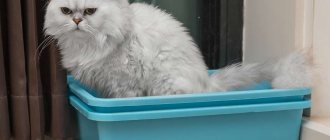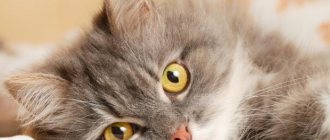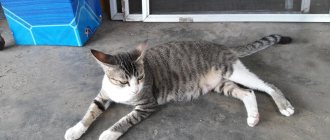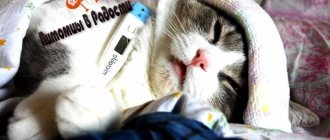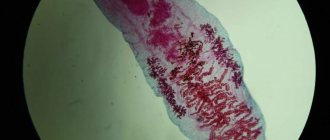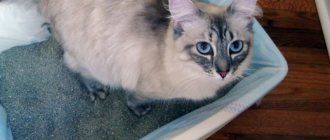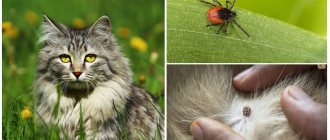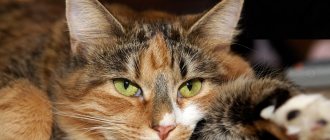Save the article:
Among all cat diseases, coronavirus infection stands out. The complexity of diagnosis, treatment and vaccination makes coronavirus in cats a dangerous contagious disease. An infectious disease, which is not always accompanied by specific symptoms, can be fatal.
What is coronavirus
This disease has become quite common since the last century.
Until now, its treatment has been a challenge, since an effective vaccine against it has not yet been invented. The first official mention of the disease with characteristic symptoms appeared in the United States of America in 1960. However, it is believed that the pathogen was discovered several decades earlier.
Infectious peritonitis is common in all countries of the world. In addition to the bulk of reports of a terrible illness in pets, it was diagnosed in lions, leopards, cheetahs, jaguars, lynxes, caracals and other representatives of the cat family. On the territory of Russia it is often found among domestic animals, but among zoo animals - only among manul cats.
The causative agent of the strain is called a complex RNA virus. It is round with protrusions resembling a crown. Its discovery by scientists occurred recently, so there is no established scheme for vaccination and therapy. There is also no clear understanding of its nature. It has only been established that it is capable of mutation from a simple type to a more harmful one.
Doctors know of two types of coronavirus in cats:
1. Enteric strain (FCoV)
, which does not cause serious consequences for the cat. This form affects the cells of the small intestine, resulting in enteritis. Recovery occurs quickly, but the pet becomes a carrier of the infection for life.
2. Highly pathogenic type (FIPV)
, which is a dangerous form. It spreads throughout the body, causing fatal peritonitis. White blood cells - leukocytes - are also damaged.
The mutation of one strain into another, more dangerous species is the result of the pet’s low immunity and constant stress. The highly pathogenic species is much less common, but almost always causes death. Peritonitis is considered incurable if detected late. Despite the fact that the causative agents of the disease are the same, the symptoms are significantly different.
Scientists tend to distinguish between dry and wet infections. In the wet form, fluid accumulates in the abdomen, causing ascites. The doctor removes excess moisture from the abdominal cavity, and then transfers it to the dry subtype, followed by treatment.
The bacterium itself quickly dies outside the body, maintaining slight resistance to external factors for 24 hours. It is not transmitted from animal to person, but for other pets it can be deadly.
Disease prevention
Pfizer has developed the only intranasal vaccine designed to protect against the coronavirus, Primucell. However, veterinarians cannot guarantee absolute protection to owners of vaccinated cats. There are a number of good reasons for this:
- Primucel was created to prevent coronavirus peritonitis.
Veterinarians do not provide a 100% guarantee of protection after vaccination.
- If the cat is already infected with the virus, then the vaccination will provoke the emergence of an infectious process.
- The effectiveness of Primucel has not yet been scientifically proven.
Most veterinarians recommend preventing coronavirus infection by following simple rules:
- the cat must have comfortable living conditions (cleanliness, dryness, etc.);
- the animal’s diet should be balanced (with plenty of vitamins and microelements);
- it is necessary to observe basic hygiene rules;
- the pet’s habitat must be regularly disinfected;
- Each new kitten must be shown to a veterinarian before moving into the house;
- Contact of a domestic cat with stray animals should not be allowed;
- in order for the cat’s immunity to resist viruses, complications must be prevented (all diseases must be treated immediately and quickly);
- the cat must be periodically treated for fleas and worms;
- the animal should not experience stress (this reduces immunity).
Coronavirus in cats is a viral infection that most often affects kittens and young cats under 2 years of age. The virus enters the animal's body and leads to a chronic form of the disease. When immunity decreases and other negative factors appear, the virus strain mutates. This is how more severe, complicated forms of the disease appear. The most common signs of coronavirus are infectious peritonitis and enteritis. Treatment in both cases is symptomatic and antibacterial. However, therapy does not always lead to the desired result; many cats die from this infection.
Sources of infection
Young cats under two years of age, as well as older animals, are most at risk of contracting the virus. Only born kittens can receive it from their mother, which is why the death of the babies will be almost inevitable. Low immunity, poor heredity, unsanitary living conditions become factors that provoke the disease.
It has been established that the main source is contact with an infected individual living in the same territory, encountered on a walk or provided for mating. It is not for nothing that the disease is called a problem for all nurseries, since overcrowding has a beneficial effect on the spread of infection. There is evidence that from 50 to 85% of nursery inhabitants are sick or are passive spreaders of the strain.
Don't forget about this when buying a kitten. You must ask the seller for veterinary documents reflecting the results of tests performed and information on primary comprehensive vaccination.
The penetration process is facilitated by:
- eating excrement;
- use of shared hygiene items or utensils;
- unsanitary conditions of detention;
- constant close contact of cats with each other.
Pets that exist separately from their relatives are least susceptible to infection. If a cat lives alone with its owner, gets little walks, and encounters with other cats are kept to a minimum, then the likelihood of contracting an infection is practically non-existent. However, there have been cases of the bacteria entering homes through infected feces, particles of which end up on the wheels of a bicycle, baby stroller or the sole of a shoe.
Signs do not appear immediately. The incubation time for development within the body is about three weeks, but in weakened or old animals, manifestations will begin within 3-4 days.
Probability of infection
Veterinarians are still arguing about why some cats become infected with coronavirus, while others are spared the disease. Many experts are of the opinion that the animal’s immunity plays a major role. As a rule, the strongest organism is found in young healthy individuals aged 2 to 8-10 years. Accordingly, the risk group includes:
- kittens up to 1 year, large breeds – up to 1.5 years;
- elderly individuals - from 10 years and older, thoroughbreds - from 8 years and older;
- albino and allergic animals;
- animals with a chronic disease or recently recovered from it.
Of course, even a young, healthy cat can catch the coronavirus. Its susceptibility will be determined not only by the strength of the immune system, but also by the type of virus.
Danger to humans
Much to the relief of many owners, the coronavirus is not transmitted to humans. But this does not mean that precautions do not need to be taken - people can become carriers of the infection.
If your cat is sick with coronavirus, try to limit your contact with other animals so as not to transfer the strain to them. Disinfect the room – and more than once. Maintain a strict cleaning schedule.
If you have other pets, if possible, temporarily relocate them to another house or apartment to prevent them from becoming infected. This applies not only to cats, but also to dogs.
Prevention and vaccination of coronavirus
The best prevention option would be a coronavirus vaccine. Work on its development has been ongoing since the early 90s of the 20th century. American scientists have obtained the Primucell vaccine, which is administered intranasally into the cat’s body. Despite the high cost of the vaccine, its effectiveness is not high enough. In addition, the coronavirus vaccine is rarely used in Russia.
Since intestinal coronavirus is most often found in large cat populations, preventive measures include mass serological surveys of shelters and nurseries. Carriers and already sick cats and kittens are isolated. This measure, in parallel with antiviral prophylaxis, makes it possible to keep under control a dangerous disease spreading among purebred animals.
To avoid treating cats in the future, you should keep the premises clean. It is recommended to regularly treat cat personal hygiene items with disinfectants. Coronavirus dies at high temperatures, in ammonia, 3% sodium hypochlorite solution.
To maintain a cat’s immunity against coronavirus, it is necessary to organize a nutritious diet, monitor the deworming schedule, neutralize stressful situations, and create physical activity according to age. Such prevention can serve as a good alternative to vaccination.
global $ads_google; //data-ad-slot=”2475549904″ $ads_google = empty($ads_google) ? false : true; ?> if ($ads_google == false) {?> $ads_google = true; ?> } ?>
Forms of the virus
The course of the disease directly depends on the bacteria that has entered the body of the individual. They build on it when prescribing medications and therapy. There are three options for the development of malaise:
- asymptomatic;
- easy;
- heavy.
First option
considered the most common. This strain poses a threat not to the carrier, but to domestic relatives living in the neighborhood.
Mild course
typical for adults. Infection with bacteria provokes the development of enteritis. Diarrhea, high fever, runny nose, eye inflammation, and vomiting accompany the disease. The animal experiences pain in the abdomen, and a white coating forms on the tongue. Coronavirus enteritis in cats combines symptoms of poisoning and colds.
Severe leakage
associated with a sharp deterioration in condition, loss of appetite, and vomiting. Weight loss begins, mucous membranes begin to turn pale. With the wet subtype, ascites develops - accumulation of fluid in the abdomen, dysfunction of the kidneys, liver, and vascular damage. Muscle tissue gradually loses elasticity, and cramps are possible due to disturbances in the functioning of the nervous system.
The dry subtype is characterized by a sharp decrease in weight, and in later stages – a problem with the functioning of internal organs. The infection often combines both types or one begins to mutate into the other.
Wet inflammation without proper treatment lasts for about six months, then becomes dry, causing the death of the pet. Dry peritonitis is considered chronic, slowly and over a long period of time destroying the cat’s body.
Routes of infection
How is coronavirus transmitted in cats? One animal becomes infected with coronavirus enteritis from another, mainly through feces. A rare method of infection is transmission of the virus through saliva. The possibility of spreading the virus by air has not been confirmed. FIPV generally multiplies and lives in blood cells, not intestinal cells, and therefore cannot be excreted in feces or saliva. Infectious peritonitis occurs as a consequence of infection with enteritis coronavirus, which then mutates into a form that affects blood cells. Coronavirus enteritis, not FIPV, is transmitted from one cat to another through feces.
A short video about how coronavirus is transmitted:
Is coronavirus transmitted to humans and animals?
Feline coronavirus infection is harmless to people and other pets. Only cats that come into contact with a carrier or a sick animal can “catch” the infection. Pet owners need not worry: they are not at risk of contracting coronavirus.
Stability of coronavirus in the external environment
The coronavirus is extremely unstable in the external environment. Animal viruses lose activity outside the host within 24 hours. You can deal with them by heating and using disinfectants. The virus remains stable at low temperatures and low pH levels. It is also resistant to phenols.
The virus does not like dry surfaces and is destroyed when the external temperature rises. To prevent the disease, promptly carry out hygienic treatment of bowls and disinfection of the toilet, exclude contact between the cat and infected animals and street walks.
Main symptoms and signs
The incompletely understood appearance of the strain makes it difficult to quickly identify the problem. Even an experienced veterinarian, when diagnosing a disease, can be confused due to the large number of symptoms. Because of this, conclusions that are not always correct are often made. Sometimes the owner needs to insist on involving several qualified specialists in the identification and examination, who can confirm or refute the previously received diagnosis.
Incubation period
Unfortunately, neither the owner nor the doctor is able to notice the coronavirus while it is at the initial stage of development. The incubation period does not involve any external manifestations, and it can last from two weeks to one month.
The only way to detect the disease at an early stage is to get tested. Diagnosis at a veterinary clinic is strongly recommended in the following cases:
- the indoor cat met his street brothers;
- you moved into a house where other animals previously lived;
- you took another cat or dog into your home (then it is better to examine all the animals at once);
- the domestic cat has been outside, had contact with suspicious objects, marks of other cats;
- If the cat regularly goes outside, it is better to get tested quarterly.
Such a strict, at first glance, check will protect your pet not only from coronavirus, but also from other, no less dangerous and unpleasant diseases.
First manifestations and symptoms
As soon as the incubation period ends, a severe stage of the course begins. It is expressed by one or more signs. Their list is very extensive:
- lack of appetite;
- frequent vomiting, diarrhea with blood or mucus;
- weakness, depression;
- alternation of high and low body temperature;
- unexpected attacks of aggression, panic, inappropriate behavior;
- fear of light, search for a shaded room;
- change in color of the oral mucosa and gums from red to light blue;
- germination of blood vessels in the cornea;
- bloating of the abdominal cavity due to accumulated fluid;
- decline in immunity at the cellular level.
The wide variety of manifestations is explained by mutations of infected cells. Not all signs occur even with the highly pathogenic form of coronavirus in cats. How many there will be depends on each specific case. For example, an asymptomatic appearance does not entail any consequences visible to the owner. A mild form suggests a gastrointestinal disorder, which is associated with poisoning or overeating.
The most terrible subtype develops gradually. It all starts with digestive problems, then the cat’s kidneys, liver and nervous system are affected, causing painful, hard-to-bear cramps.
Symptoms of FIP in cats
The virus that causes IPC is referred to in the international classification as FIPV and is capable of causing various manifestations of damage to many organs and systems in the body of cats.
The name of the disease is due to the fact that often one of the main clinical signs is peritonitis.
It is accepted to divide the course of IPC into three main forms:
- Wet IPC. In this form of peritonitis, due to damage to the blood vessels of the peritoneum or pulmonary pleura, exudate effusion occurs into the abdominal or thoracic cavity. The development of wet peritonitis is provoked by a weak immune reaction of the body; this form of the disease occurs mainly in kittens. The disease is accompanied by fever up to 40 C, weakness, lack of appetite, peritonitis, with accumulation of effusion in the abdominal cavity, and gradual exhaustion.
When effusion forms in the chest cavity, the disease is accompanied by breathing problems and wheezing.
If the animal does not die in the first weeks, then signs of peritonitis or breathing problems are accompanied by symptoms of renal and liver failure, manifestations of pancreatic dysfunction.
The duration of the wet form of infectious peritonitis is about 6 months. The outcome is fatal, or the disease develops into the form of dry IPC.
- The dry form of peritonitis is characterized by the absence of effusion fluid. This form of peritonitis affects older cats. The disease occurs without pronounced symptoms. A decrease in appetite and physical activity may be noted. With this form, diagnosing the disease is very difficult, this is explained by the absence of pronounced clinical signs. In a later period, multiple signs of damage to internal organs appear, most often the liver and kidneys, less often the nervous system (weakness of the hind limbs, paralysis, paresis, convulsions, behavioral disorders - aggression or apathy) and eyes (hyphema, retinitis, iridocyclitis).
- Hidden form. It is characterized by a long course without the manifestation of any clinical signs. In the latent form, only blood macrophages are affected and the animal can be a virus carrier for a long time without showing signs of the disease. Periodically releasing the virus into the environment, the cat, which is a virus carrier, infects healthy animals.
In the latent form, the animal’s body either gets rid of the virus over time, or, if the immune system is weakened, the disease progresses. Viruses from immune blood cells penetrate the internal organs, where characteristic granulomatous nodules and compactions develop.
The dry form of the disease can turn into a wet one, or they occur simultaneously.
Diagnosing coronavirus in cats
Currently, there are no clearly developed medical tests to quickly and unambiguously determine the type of virus - enteritis or peritonitis. But there are a number of tests that can more accurately draw a conclusion about a problem with internal organs.
First of all, stool is analyzed for PCR and ICA three times over two weeks. The test indicates the presence of infection in the excrement. A negative result indicates not only its absence, but also a hidden disease that threatens healthy relatives.
If the signs clearly appear, then do the following studies:
:
1. Serological blood test
animal that can detect the presence of antibodies. The analysis does not allow determining the location of bacteria, and a negative result does not indicate its complete absence. This is sometimes caused by severely depleted immunity.
2. Blood polymerase chain reaction (PCR)
RNA detector. The test is not considered accurate and sometimes produces false positives and false negatives. The first is possible due to low virus activity, the second may be due to a lack of biomaterial for research.
3. Blood antibody titer
, capable of establishing the quantity and concentration of antibodies. The analysis helps to find out how severe the variant is in the animal. The highly pathogenic type is defined by a titer of 1280 antibodies or higher.
If peritonitis is suspected, it is necessary to urgently perform a biopsy and histology of the infected tissue. A puncture is taken from the abdominal cavity, removing fluid for analysis.
With the development of veterinary medicine, rapid tests have appeared everywhere to recognize coronavirus in those who have come into contact with sick cats. Such a test can identify the problem at an early stage and begin adequate therapy in time.
How can an animal become infected?
global $ads_google; //data-ad-slot=”2475549904″ $ads_google = empty($ads_google) ? false : true; ?> if ($ads_google == false) {?>
$ads_google = true; ?> } ?>
The infection is contagious, therefore, among all sources of infection, the virus-carrying animal takes first place. It doesn't matter whether he shows symptoms or not. In this regard, any accumulation of cats on the street, nurseries, shelters, and even accidental contact with a sick individual pose a danger.
Indirect communication through shared care items also plays a role. The source of the coronavirus can be food and water bowls, a tray, and beds. They contain saliva or traces of excrement through which the microbe is transmitted. After a sick cat, the virus lives on objects for another 24 hours, after which it is destroyed. Eating the feces of relatives on the street is also a risk factor for cats, since the coronavirus remains viable in them for much longer - up to several months.
How to treat a pet
At this stage of medical development, there is no single method to get rid of a dangerous strain forever. There is not a single medicinal complex that can cure a furry patient. Immunologists are delayed in creating a vaccine against coronavirus in cats.
General therapy
Currently, the therapy used eliminates only the symptoms, preventing the occurrence of complications. Almost every recovered individual becomes a carrier of the infection inside its body.
in a cat is treated in several stages and techniques
:
- prescription of antiviral medications;
- taking corticosteroids and antibiotics to eliminate inflammatory processes;
- prescription of immunomodulators to increase protective functions;
- the use of sorbents that allow the removal of toxins and waste from the pet’s organs (“Polysorb”, activated carbon, “White coal”);
- taking protectors or prebiotics to treat secondary factors of the disease;
- the use of antispasmodics using intramuscular injections (no-spa, papaverine);
- prescription of antiemetic drugs (Metoclopramide, Pro-chlorpromazine);
- the use of droppers with glucose solution, vitamins for severe dehydration or weight loss;
- collection of fluid from the pleural and abdominal cavity.
Drug "Poliferrin-A"
considered one of the best immunomodulators. Being an analogue of colostrum, the drug has a strong antiviral and anti-inflammatory effect.
Another medicine known as Roncoleukin
, allows you to stimulate the awakening of weakened immunity.
The drug "Globcan-5"
provides the mustachioed pet with the necessary antibodies.
Sometimes your veterinarian will prescribe human immunomodulatory medications. However, they are prohibited when the strain mutates into a more severe subtype, so as not to worsen the patient’s condition.
Treatment of enteritis
Relieving intestinal inflammation begins with strictly limiting the furry pet's diet. The suffering patient is not fed at all for the first 24 hours after diagnosis of the disease, leaving only fresh drinking water available. If the dehydration of the body is very severe, then special glucose solutions or vitamin preparations are used to maintain optimal electrolyte levels.
If the course of the disease is favorable, oatmeal porridge boiled in water is given on the second or third day. Viscous cereal envelops the intestinal walls, thereby accelerating the recovery of the damaged organ and increases the motility of the gastrointestinal tract. On the doctor’s recommendation, a small amount of lean minced meat is added to the diet a few days later.
Often, veterinarians perform intestinal lavage using castor oil or Glauber's salt. The use of these drugs depends on the complexity of the inflammatory process. In case of severe frequent loose stools, the patient is prescribed astringent medications, which are given under the strict supervision of a doctor.
If the high body temperature does not subside and the diarrhea does not stop, then the specialist prescribes a course of antibiotics, which should stop the development of complications against the background of a spreading infection. Such medications can be prescribed by injection, dropper, or tablet.
Viral enteritis involves antiviral rehabilitation and the prescription of immunomodulatory medications to restore the body's protective functions. In case of hemorrhage in the digestive section, hemostatic drugs with vitamin K are used. To ensure faster recovery of the infected area, taking vitamin-mineral complexes is indicated.
Features of the treatment of peritonitis
Can severe intestinal inflammation be cured? This question worries every owner of a cat with this terrible disease. Unfortunately, the mortality rate for this diagnosis is about 90% of cases. There is no single adequate treatment, but there is a set of measures aimed at maintaining a more or less normal condition of the infected patient.
The prescription of painkillers is aimed at blocking severe pain. Ice compresses are used for the same purpose. They are applied to the inflamed abdominal cavity to at least slightly relieve the acute pain. The set of measures directly depends on the type of inflammation diagnosed.
The viral form involves taking antiviral medications plus medications that reduce pain. In addition, immunostimulants and vitamin complexes are prescribed. For infectious inflammation, antibacterial solutions and antibiotics are used as intramuscular or subcutaneous injections.
The dry type is treated with immune-boosting drugs, pain-relieving injections, and a course of antibiotics. To reduce intoxication, glucose solution and saline solution are used.
If your pet is suffering from wet peritonitis, your veterinarian will perform intestinal lavage, which pumps out fluid from the abdominal cavity. This procedure will help reduce pain. A course of vaccinations with an antibiotic is also prescribed.
In general, all measures against inflammation are aimed at preventing possible complications. Any owner of a home mustache should remember that it is easier to prevent inflammation of internal organs than to cure it.
Will the pandemic lead to an increase in the number of homeless animals?
In a number of countries, the number of stray animals has increased sharply amid the pandemic. For example, in Wuhan, about 50 thousand pets were left unattended. The trend, although to a lesser extent, has affected many countries with a high incidence of COVID-19. Some owners ended up in the hospital, others went out on their own and couldn’t return, and the owners can’t go searching because of quarantine.
“It is not written on the animal for what exact reason the owner decided to get rid of it, you just see the result - it ended up on the street and is trying to survive there,” says Natalya Antipina, a volunteer of the “House of Lost Cats” project. — This spring, there are a lot of homeless people, this is an observation. The situation with the welfare of animals in our country is, in principle, unfavorable - they are bred uncontrollably and, accordingly, thrown away, this is a mass phenomenon even outside of the pandemic situation. Quarantine and the isolation associated with it have greatly aggravated all these problems. In addition to the fact that due to misunderstanding, animals are seen as a threat of COVID-19 infection. In isolation, cases of cruelty to animals have become more frequent.”
Natalya Antipina also notes the opposite trend. “People began to make impulsive decisions with the formulation “adopt an animal during quarantine - entertain the child, find a reason to go for a walk.” One can only guess about the fate of these animals. Unfortunately, this widespread phenomenon is likely to lead to a new wave of homelessness once the lockdown ends.”
Caring for an infected person
During the treatment period, it is important that your pet receives appropriate care. The diet should also be reviewed. For example, if he received industrial feed before his illness, now he needs to be switched to natural food. The transition should be gradual, but mandatory. The consumption of protein contained in meat products is determined by the need to restore the tissue of the affected intestine as quickly as possible.
The cat should drink a sufficient amount of clean water. On the recommendation of a veterinarian, the patient is given decoctions of rosehip or stinging nettle. The doctor prescribes vitamins that help boost the pet’s immune system. Regular deworming is mandatory to maintain a normal standard of living.
Unsanitary living conditions negatively affect a cat’s recovery, so cleanliness is needed not only for the cat itself, but also among bowls, trays, various hygiene items, and toys. When two or more relatives live together in the same territory, they are provided with separate plates and toiletries.
Intestinal infections are treated only under the supervision of a veterinarian. Only a specialist can monitor the patient’s condition or change the treatment conditions during regular examination of the infected patient.
Specific signs of the disease
A person with a strong immune system may only have a slight rise in temperature, swelling of the nasal mucosa, and a feeling of a “lump” in the throat. With timely treatment, these symptoms quickly disappear and the patient recovers. But the clinical picture is different for the development of SARS, or severe acute respiratory syndrome. It manifests itself as follows:
- fever;
- weakness;
- chest pain;
- shortness of breath;
- cough with sputum.
SARS is often preceded by only minor signs of any respiratory infection, such as nasal congestion. Their severity is growing rapidly. With COVID-19, a seemingly healthy person in the morning may end up in the intensive care unit in the evening.
If coronavirus immediately manifests itself as breathing problems, urgently seeking medical help will help avoid lung damage.
If an adult or child has a strong immune system or takes antiviral drugs to treat other diseases, then the incubation of coronaviruses is delayed. It often takes about two weeks after infection before the first respiratory symptoms appear. Doctors strongly recommend that you immediately seek medical help and not self-medicate.
Causes of infection
We will dwell on this point a little more to better reveal the features of this disease. By the way, sometimes the clinical picture is not clear, as we described above, but blurred. For several days, the animal may be lethargic, eat poorly or completely refuse food, but the cat does not experience diarrhea or vomiting, which means the suspicion of coronavirus does not fall. As a result, by the time symptoms clear up, it may already be too late. Therefore, it is very important to receive veterinary services in a good clinic, where experienced doctors work.
Veterinary experts have been researching this disease for a very long time. During these studies, it was found that quite often the coronavirus is found in a dormant state in the intestines of felines. If conditions suitable for the virus arise, it takes on an aggressive form and causes inflammation of the intestines, or even mutates. Moreover, in most cases, risk groups are young animals and cats who have reached 11-12 years of age. Veterinarians are trying to find out what exactly is the trigger for the onset of the development of the disease, but the number one task is to identify the genetic or other characteristics of the body that allow the individual to remain completely immune to the virus. This would open a new chapter in the history of veterinary medicine.
Is feline coronavirus contagious to humans?
Very often the question arises whether feline coronavirus is dangerous for humans and whether it is possible to become infected from a sick animal. Numerous medical studies have been conducted on this matter, during which it was found that a person cannot get sick from a cat.
This disease poses a danger only to other felines, but does not pose any threat to humans. Therefore, when asked whether cats can infect humans with coronavirus infection, doctors answer negatively.
Treatment options
There is no specific treatment for coronavirus. Experts continue to work in this direction. But the most important thing is to identify pathology in the early stages. If you notice the first symptoms, you should immediately contact your veterinarian. Antiviral drugs are used to treat the disease at the initial stage. Sources of interferon, ribaverin, immunomodulators. Their main goal is to slow down the process of virus reproduction in cells and enable the body to cope with them. They do not have a therapeutic effect, but they stop the development of the infection.
Antibiotics and corticosteroids are prescribed in combination with antiviral drugs. They reduce inflammation and reduce symptoms. But such actions are not complete treatment. The rest of the therapy is symptomatic. Individual nutrition is developed for a sick pet, with a predominance of dietary food. Veterinarians also observe changes in body temperature and pressure. If necessary, appropriate medications are administered.
Constant vomiting and loss of appetite dehydrate the body. Therefore, the doctor prescribes the administration of saline solution with glucose. Experts do not recommend supporting the strength of a sick pet’s body with vitamin and mineral complexes.
For diarrhea and vomiting, chloramphenicol and noshpa are administered intramuscularly. If a wet form of the disease is observed, then effective treatment involves removing ascites fluid. In addition, sorbents are used to remove toxins; regular intensive care is required. To boost immunity, cats are given infusions of various herbs. Among them are stinging nettle and rose hips. The duration of treatment is determined by the veterinarian.
Good care and concern combined with symptomatic therapy provide an excellent chance of recovery. Even with infectious peritonitis, it is possible to keep the animal alive for many months. To do this, accumulated liquid is periodically pumped out. You should not euthanize your cat immediately after diagnosis. In this case, you should immediately seek help from a specialist.
